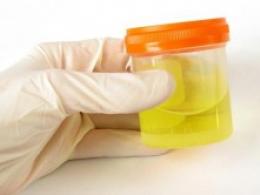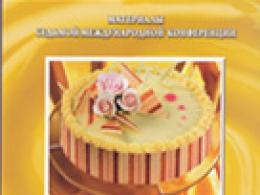Craft paper applique lilac. How to make a lilac out of paper with your own hands. How to make an application "Lilac" from colored and corrugated paper with your own hands? Step by step instructions for children and adults
The easiest to learn and the most popular craft material is, of course, paper. With proper skill and diligence, almost anything can be made from it. And any kind of flowers from this material is even more so.
We continue to expand the border of paper floristry and do-it-yourself paper lilacs are next in line.
By tradition, let's start by showing the result. As a result, we will get such flowers.
Now let's proceed directly to the analysis of the procedure for making lilacs from paper. And first we will make the basis for the flowers. Take a rectangular sheet of lilac (purple) paper. We bend the strip along the long side, as shown in the figure.
After we fold the sheet in half and make transverse cuts to the fold strip. You will get such a fringe.

We turn the resulting strips, as shown in the diagram below. The tighter and smaller the lump, the better.

Let's temporarily leave the paper blank for the lilac flowers themselves and proceed to the manufacture of the stem. Roll up a tube of green colored paper. If you want to strengthen it, then you can put a piece of wire inside (thin stick, knitting needle, etc.).

Again, take a blank for flowers. Lubricate the left lapel along the entire length with glue. We begin to glue it to the stem. Spiraling. The picture shows everything in detail.

If desired, the folded strips-petals can be fluffed a little.
The final element in making paper lilacs is the leaves. Take a couple of pieces of green paper. We fold them with an accordion.

We cut the resulting accordion with scissors on both sides and give it the shape of an oblong sheet. We expand it. Get a lot of leaves at once.

We glue them to the stem, wait until the glue dries and the craft is ready.
Flowers made with your own hands from paper will decorate your home interior, becoming the main highlight in it. Today you will learn how to make a lilac branch from ordinary colored paper. The technique for creating this craft is quite simple, but it’s worth it to be patient.
Before we get started, have the following tools and some supplies ready:
- scissors;
- two-sided colored paper of lilac and green color;
- crepe or corrugated green paper;
- three pieces of thin wire;
- glue stick.
Miniature lilac flowers are created first. We cut off several wide strips of lilac color 4-5 cm wide.

We fold these segments four or six times and begin to make small cuts along their entire length.


Then we lay out the resulting blanks. Using the blades of scissors, we twist the strips.

Try to carefully run the scissors along the thin fringe, otherwise they may come off!
We process three pieces of wire with crepe or corrugated green paper.

Secure the ends securely with glue. Let the pieces dry completely.
Now we need to wind the lilac ribbon around the resulting twigs. We start from the very tip of the wire, gradually going down.



After we collect the flowers, slightly lifting them up. Be sure to fix the tip of the lilac ribbon with a drop of glue.
When the flowers are ready on all three pedicels, we connect them with a crepe ribbon into one branch.


Small shoots of lilac should be placed on the sides. Place the long branch in the center.




Attach them with glue to the bottom of the branch.


Let the glue dry completely.
Now the lilac branch is ready!





Make a few more of these branches of the same or a different shade and create a small composition from them. Decorate your room with the resulting bouquet. You can also decorate a solemn interior with a bouquet of paper lilacs.
To lilac sprig decorated your room always, you will need some materials. The main element, the lilac leaf, is best prepared in advance, it will come in handy. Or you may need several. Do not forget to collect a few leaves when you admire lilacs in a park or square.
So let's get started.
We prepare materials: several album sheets, gouache, paper napkins, colors suitable for lilac flowers, paint brush, PVA glue, scissors, lilac sprig.

We put a sheet of lilac on the table with the back side facing us and apply paint on it: green, yellow, blue. Colors may not be mixed.





Now turn the leaf over, gently press it with a napkin and leave an imprint on the paper. On the back of the leaf, all the veins are clearly visible, which leave marks on the paper. From this, the print is even more realistic and the leaf on paper turns out just like a living one.




In the same way, we prepare a few more prints. Please note that by applying the paint once, you can get several prints of different intensities. So, all the leaves we get will be different, as it happens in nature.


Prepare the basis for our applications. Apply a layer of water and a layer of white gouache to a vertically positioned sheet of landscape paper. Then, without waiting for a primer coat, paint the sheet in horizontal stripes in several colors, from light at the top to dark at the bottom of the sheet. Leave for a while to dry the base.


In the meantime, the base dries up, cut out the leaves obtained by printing on paper.

Let's prepare lilac flowers. To do this, cut off the folds of a single-layer napkin folded in four so that 4 squares remain.


We cut the napkin in half, then each rectangle again in half lengthwise, and then in half across, thus obtaining as many as 16 from one square.


Now each square must be rolled into a ball in any arbitrary way. Let the lumps be shaggy and not very neat, our lilac will be richer and more voluminous from this.

On the sheet prepared for application, we will draw a future branch, the core of our picture.

Lilac leaves can be given extra volume by wrapping them around a pencil or shaping them with your fingers.

Let's attach the leaves to the branch, let's see how harmonious they look. You may have to set aside one or two leaves, at the end of the work and they will find a place


In order for our branch of lilac to bloom, we apply PVA glue to the tip of the branch, but do not smear it, make a few drops. We will lay napkin blanks on them, repeating the conical shape of the lilac brush.




You can make several such brushes by choosing a different number of flowers of different shades of lilac.




And now the last, fifth, lilac leaf has found its place. We fix it with glue.


For older children, it is possible to perform another version of the application. The complexity of this work is slightly higher than in the previous master class, but it is not difficult to cope with it.
On the landscape sheet, draw a branch with a marker or felt-tip pen.

Just as in the first embodiment, we will prepare a lilac leaf. Let's apply gouache on its back side: green, yellow and blue in arbitrary proportions. Only we will leave the print not on a separate sheet, but immediately on the main sheet.


Gently press the leaflet to the paper, holding it with a napkin.

If the print is smudged, you can touch it up slightly with a brush.
Make some leaves.


Spring. The trees dressed up in green dresses, and the lilac blossomed in lush color. Its branches attract the eyes of children and are eager to take a place in children's creativity. They can be depicted in the form of a picture, bulk crafts and .
The application "Lilac" can easily acquire volume if it is created using paper ones.
To make the application "Lilac" from napkins more realistic, you need to choose napkins of the most similar shade - lilac or pale pink. In addition to napkins, you will need a thick white sheet, watercolor, brown smooth and green, scissors, a brush and glue.
We tint the white sheet with pale blue watercolor - to match the spring sky.

Cut out a vase from brown paper and glue it on.

We put a few thin green stems in a vase.

To each of them we glue the silhouette of a lilac sprig cut out of a napkin.

The rest of the napkins are cut into equal squares.

Each square is carefully turned into a small colored one. This is a rather painstaking work, which is difficult for kids to cope with. Therefore, it is better if the application "Lilac" is made in the older group.

Lumps begin to alternately cover the contours of the inflorescences. Lubricate them with a thick layer of glue and carefully fix the lumps.

Thus, we cover each contour.

At the base of each branch, glue a cut out of dark green corrugated paper leaflet.


Now we shade each branch, giving it volume. To do this, apply a darker shade of paint with a brush.

Before our eyes, the lilac comes to life and becomes more magnificent.

Ready! We got a real spring lilac.

For children, in the process of its manufacture, it certainly revealed new possibilities: they learned how to create volume with paint and lay out the contours with crumpled napkins. These skills will definitely come in handy in the future.
Spring has come and the symbol of spring has always been lilac. In this master class you will find the idea of creating lilacs from corrugated tubes. Such a picture will refresh the interior, it will smell of spring and renewal.
We will need:
- ceiling tiles (only not half, but a whole square),
- glue Titanium and PVA,
- scissors,
- napkins (the simplest, single-layer),
- corrugated paper.

We crumple a yellow napkin, straighten it and glue it on the ceiling tile. We glue it only along the edge.

And we begin to cut out our curtains. At first I wanted to make the curtains more authentic and with a lambrequin, but then I changed my mind.

We take the upper part of the curtain, glue it along the edges, but the curtain should be sort of gathered. And then glue the gathered top and bottom of this half of the curtain. And we do the same for the lower part of the curtain.

Then we make a corrugated single tube.

On a strip of corrugated paper (here only green paper) we wind a barbecue skewer and glue the edges.

And gently, holding with one hand, with the other we begin to compress the paper.

And attached to the place of assembly.

We do the same for the second curtain. We do not pay attention to the joints of the yellow napkin, everything will be covered by a bouquet of lilacs.

We make a table from a green napkin.

And we begin to make lilac branches. For a long time I thought about how to make a lilac, someone wrote on the Internet that he uses papier-mâché from cotton wool, so I thought that maybe lilac can be done in the same way ... I don’t know if this is so, but I decided to do it this way . We take cotton wool, pour PVA glue and coat the cotton wool with glue. And we dry.

It turns out such dry cakes.

Approximately spread out.

And she began to trim the first brush of lilac. I started with PVA glue, but the trims did not hold well, so I began to work with Titan glue.

Here is the whole cake wrapped. We do the same with the rest.

Fitting.

Now let's make a vase. They made tubes, somewhere around 14 pieces.

And lay out the outline first.

And then we fill the whole vase.

All brushes are glued, one branch is on the table.

Now we need to trim our lilacs to hide the cotton wool and give the branch a more natural look ... for this we add trimmings along the edge, and at the tips of the branches we give a sharp shape. Here one side is finished, and the other is not there yet and the edge of the cotton wool is visible.

Here the lilac is ready! True, the colors are not very well matched, especially the twig on the table, but what colors did I have.

Now the leaves. We cut out leaves from corrugated paper, coat the tip with glue and arrange in a bouquet.


All leaves are ready!


Now let's make a frame. Cut off the strip, bend it in half and wind it on a stick from both sides to the middle, I have a kebab stick, but for the frame I twisted it on a pencil.


And we start to squeeze.

The frame is ready! Now we take the remaining squares from the trimmings and begin to cut them finely. Then we smear PVA glue on a green napkin and pour pieces of a napkin and leave to dry. Then turn over and the extra pieces will disappear.

Now we decorate the curtain. We take white napkin, mode into squares or rectangles and roll the balls, coating them in PVA and glue them to the edges of the curtains. I also wanted to stick hole punch circles on the curtains, but I don’t know if there will be too much.






